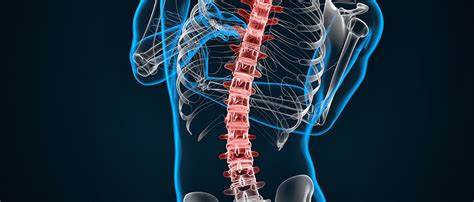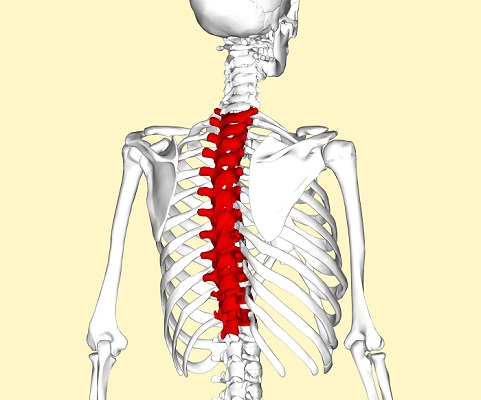Dextroconvex Scoliosis of the Thoracic Spine: Dextroconvex scoliosis is a specific type of spinal curvature that occurs in the thoracic region of the spine. It is characterized by a sideways curvature of the spine towards the right side, resulting in a C-shaped or S-shaped curve. This condition can cause significant discomfort and functional limitations for individuals affected by it. In this comprehensive guide, we will explore the various aspects of dextroconvex scoliosis of the thoracic spine, including its anatomy, causes, symptoms, diagnosis, treatment options, postoperative care, potential complications, long-term management, and future directions in treatment.

Understanding the Anatomy of the Thoracic Spine
The thoracic spine is the middle portion of the vertebral column, consisting of twelve vertebrae labeled T1 to T12. It is responsible for providing stability and support to the upper body, protecting vital organs such as the heart and lungs, and facilitating movement and flexibility. The thoracic spine is naturally curved in a slight kyphotic shape, which helps maintain proper posture and balance. However, in dextroconvex scoliosis, an abnormal lateral curvature occurs, disrupting the natural alignment of the spine.
Causes and Risk Factors of Dextroconvex Scoliosis
Dextroconvex Scoliosis of the Thoracic Spine: The exact cause of dextroconvex scoliosis is often unknown, but several factors can contribute to its development. Some common causes include congenital abnormalities, neuromuscular conditions such as cerebral palsy or muscular dystrophy, connective tissue disorders like Marfan syndrome, and idiopathic scoliosis, which has no identifiable cause. Risk factors for dextroconvex scoliosis include a family history of scoliosis, female gender (as scoliosis is more prevalent in females), rapid growth during adolescence, and certain medical conditions or syndromes.

Signs and Symptoms of Dextroconvex Scoliosis in the Thoracic Region
The signs and symptoms of dextroconvex scoliosis can vary depending on the severity of the curvature and the individual’s age. Common symptoms include an uneven waistline, shoulder or hip asymmetry, a prominent shoulder blade, muscle imbalances, back pain, fatigue, and difficulty breathing. In severe cases, the curvature can lead to compression of the lungs and heart, causing respiratory and cardiovascular problems.
Diagnosing Dextroconvex Scoliosis: Evaluation and Imaging Techniques
Diagnosing dextroconvex scoliosis involves a comprehensive evaluation of the patient’s medical history, physical examination, and imaging techniques. During the physical examination, the healthcare provider will assess the patient’s posture, range of motion, and any visible signs of scoliosis. Imaging techniques such as X-rays, CT scans, or MRI scans are used to measure the degree of curvature, identify the location and severity of the scoliosis, and rule out any underlying conditions.

Classification and Severity Grading of Dextroconvex Scoliosis
Dextroconvex scoliosis is classified and graded based on the Cobb angle, which measures the degree of curvature in degrees. Mild scoliosis is defined as a Cobb angle between 10 and 25 degrees, moderate scoliosis ranges from 25 to 40 degrees, and severe scoliosis is characterized by a Cobb angle greater than 40 degrees. The classification and severity grading help determine the appropriate treatment approach for each individual.
Non-Surgical Treatment Options for Dextroconvex Scoliosis
Non-surgical treatment options for dextroconvex scoliosis aim to prevent further progression of the curvature, alleviate symptoms, and improve the patient’s quality of life. These treatment options include observation and monitoring, physical therapy, bracing, and pain management techniques. Observation and monitoring are recommended for mild cases with a Cobb angle below 25 degrees, as the curvature may not progress significantly. Physical therapy focuses on strengthening the muscles surrounding the spine, improving posture, and increasing flexibility. Bracing is often prescribed for moderate scoliosis to prevent further progression, while pain management techniques help alleviate discomfort.

Surgical Interventions for Dextroconvex Scoliosis in the Thoracic Spine
Surgical interventions are considered for severe cases of dextroconvex scoliosis or when non-surgical treatments fail to provide adequate relief. The main goal of surgery is to correct the curvature, stabilize the spine, and restore proper alignment. Common surgical procedures include spinal fusion, where the vertebrae are fused together using bone grafts or implants, and instrumentation, which involves the use of rods, screws, or hooks to hold the spine in the corrected position. The choice of surgical intervention depends on the individual’s age, severity of scoliosis, and overall health.
Postoperative Care and Rehabilitation for Dextroconvex Scoliosis
After surgery, postoperative care and rehabilitation play a crucial role in the patient’s recovery and long-term outcomes. The patient will be closely monitored in the hospital for pain management, wound healing, and any potential complications. Physical therapy and rehabilitation programs are initiated to help regain strength, flexibility, and mobility. The patient will also receive guidance on proper body mechanics, postural exercises, and lifestyle modifications to maintain the surgical correction and prevent future complications.
Potential Complications and Risks Associated with Dextroconvex Scoliosis Treatment
Like any surgical procedure, there are potential complications and risks associated with the treatment of dextroconvex scoliosis. These can include infection, bleeding, nerve damage, implant failure, blood clots, and respiratory or cardiovascular complications. It is essential for patients to be aware of these risks and have open communication with their healthcare providers to address any concerns or questions.
Long-Term Management and Follow-Up for Dextroconvex Scoliosis Patients
Long-term management and follow-up are crucial for individuals with dextroconvex scoliosis to ensure the maintenance of the surgical correction and monitor any potential complications or recurrence. Regular follow-up appointments with the healthcare provider are necessary to assess the patient’s progress, monitor the spine’s alignment, and address any new symptoms or concerns. Physical therapy and exercise programs may be recommended to maintain strength, flexibility, and overall spinal health.
Promising Research and Future Directions in Dextroconvex Scoliosis Treatment
Research in the field of dextroconvex scoliosis treatment is ongoing, with a focus on improving surgical techniques, developing non-invasive treatment options, and understanding the underlying mechanisms of scoliosis. Promising areas of research include the use of growth-friendly implants for pediatric patients, the development of minimally invasive surgical techniques, and the exploration of genetic and molecular factors contributing to scoliosis. These advancements hold the potential to enhance treatment outcomes and improve the quality of life for individuals with dextroconvex scoliosis.
In conclusion, dextroconvex scoliosis of the thoracic spine is a complex condition that requires a comprehensive approach to treatment and management. Understanding the anatomy, causes, symptoms, diagnosis, treatment options, postoperative care, potential complications, long-term management, and future directions in treatment is essential for healthcare providers and patients alike. By staying informed and working closely with healthcare professionals, individuals with dextroconvex scoliosis can receive the appropriate care and support to lead fulfilling lives.
Referenzen
- National Institute of Arthritis and Musculoskeletal and Skin Diseases. “What Is Scoliosis?” https://www.niams.nih.gov/health-topics/scoliosis.
- Amerikanischer Verband für Neurologische Chirurgen. “Scoliosis Overview.” https://www.aans.org/Patients/Neurosurgical-Conditions-and-Treatments/Scoliosis.
- Mayo-Klinik. “Dextroconvex Scoliosis: Causes and Symptoms.” https://www.mayoclinic.org/diseases-conditions/scoliosis/symptoms-causes/syc-20353576.
- Wirbelsäule-Gesundheit. “Dextroconvex Scoliosis: Diagnosis and Treatment.” https://www.spine-health.com/conditions/scoliosis/dextroconvex-scoliosis.
- Gesellschaft für Skolioseforschung. “Understanding Scoliosis and Its Management.” https://www.srs.org/professionals/education/understanding-scoliosis.
- Nationale Skoliose-Stiftung. “Treatment Options for Scoliosis.” https://www.scoliosis.org/treatment/.
- American College of Radiology. “Imaging for Scoliosis: Guidelines and Recommendations.” https://www.acr.org/Clinical-Resources/ACR-Guidelines/Scoliosis.
- Journal of Orthopaedic Surgery & Research. “Long-term Outcomes in Scoliosis Surgery: A Review.” https://josr-online.biomedcentral.com/articles/10.1186/s13018-020-01865-8.
- Cleveland-Klinik. “Postoperative Care for Scoliosis Surgery.” https://my.clevelandclinic.org/health/diseases/17513-scoliosis.
- PubMed Central. “Scoliosis Research and Future Directions.” https://www.ncbi.nlm.nih.gov/pmc/articles/PMC2920760/.

